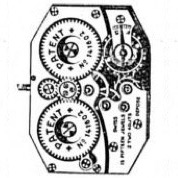 |
Brand: | 


|
|
|---|---|---|---|
| Family: |
Unknown
|
||
| Height: | |||
| Jewels: | |||
| Reserve: | 8 days hours | ||
| Frequency: | |||
| Winding: | Hand winding, Two Barrel | ||
| Diameter: | |||
| Complications: | |||
| Hands: | Central Hour Hand, Central Minute Hand | ||
| Distinguishing Technical Characteristics | |||||||||||
|---|---|---|---|---|---|---|---|---|---|---|---|
 Hand-Winding  Clockwise Balance Cock |
|||||||||||
| Production: – | |||||||||||
| 1910s | 1920s | 1930s | 1940s | 1950s | 1960s | 1970s | 1980s | 1990s | 2000s | 2010s | 2020s |
The Octo movement of the 1930s was an octagonal double-barrel movement patented as CH141602. This movement was very different from any previous 8-day movement in that it was shaped as an octagon rather than round. This shape eliminated the large single barrel so a double-barrel winding arrangement was created.
Swiss patent CH141602 was granted on August 30, 1929, to Ernest Tolck, Successeur de Marc Dubois et Cie, Fabrique Octo of La Chaux-de-Fonds. The patent expired, as shown by a notice in La Fédération Horlogère on April 1, 1936.
The octagonal movement lacks a seconds hand but has central hour and minutes. It was used in both travel alarm clocks and wristwatches, the latter typically also featuring an octagonal case. It was marketed by Tolck under the Octo brand.
Images are taken from official publications and are used here for commentary and educational purposes. Copyright is held by the original owner as noted.